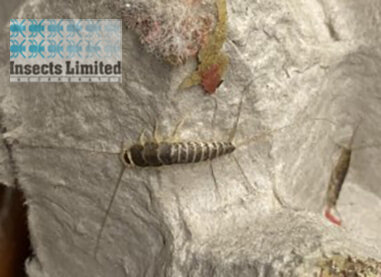Silverfish Grey (Linnaeus)
Please note that the information provided on this “Silverfish Grey | Identify Your Pest” page is attributed to MuseumPests.net.
Silverfish and firebrats are placed in the order Thysanura which is considered one of the most primitive of the living insect orders. There are four species considered common in North America; the Firebrat (Thermobia domestica), the Common Silverfish (Lepisma saccharina), the Gray or Long-tailed Silverfish (Ctenolepisma longicaudata), and the Four-Lined Silverfish (Ctenolepisma quadriseriata).
Though most are generally cosmopolitan in distribution, the Gray Silverfish is found in the Midwest to California and South. Presence of either silverfish or firebrats indicate a warm humid environment. Firebrats will favor areas of higher temperatures (95-105F) while Silverfish prefer slightly cooler environments.
Adverse to light, they tend to be found in dark areas of suitable climate with an abundant supply of food. However, their presence at a feeding site not warm or humid may indicate a nearby preferred microclimate. The color of different species can vary.


Signs of Silverfish Infestation
Damage from silverfish and firebrats on paper products is often characterized by ragged scraped areas and irregular holes. Damage to textiles is indicated by the presence of feces (described as small, dark, and visible to the naked eye), scales (visible with a hand lens), and ground fibers. A yellow stain is often apparent at the damaged area.
Grey Silverfish Life Cycle
Eggs of the Silverfish tend towards a yellowish white hue. Generally eggs hatch anywhere from 19-45 days and young spend 3-4 months as nymphs. The average lifespan for the various silverfish species can be from 2-3.5 years. Sexual maturity is reached in a few months. With a high birth rate both species can multiply quickly and have an enormous biotic potential.
Control and Treatment
Silverfish and Firebrats thrive in warm moist environments. Climate control in terms of reducing humidity and lowering temperature can cause populations to decline significantly. Also controlling nearby micro-environments where pests can migrate from is important.
Controlling food sources such as removing part of a collection is advised. It is also recommended whenever possible that books and documents be placed in sealed containers. Cleaning around bookcases in cracks and crevices with a HEPA vacuum and sealing afterward can reduce potential breeding habitat.
